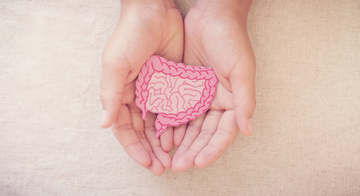
If you have irritable bowel syndrome (IBS), chances are you’ve heard of the low FODMAP diet. But what is it, and how do you know if it’s right for you?
IBS Explained
IBS is a common digestive condition which affects how the gut moves and functions, causing symptoms like tummy pain, bloating and a change in bowel (poo) movements – usually constipation, diarrhoea or a mixture of both.
IBS affects around 1 in 7 people globally and can really impact daily life, so finding ways to manage symptoms is an important goal for many people with IBS.
One of the approaches to managing IBS symptoms is through changes to diet – and one of the most popular diet therapies is the low FODMAP diet. So what exactly is it, and how does it work?
9 in 10 people with IBS report that certain foods make their symptoms worse
What is a Low FODMAP Diet?
The low FODMAP diet is a type of elimination diet developed by researchers at Monash University in Australia. It is designed to help improve gut symptoms (like bloating, pain and bowel habit) in people with irritable bowel syndrome (IBS).
Positively, research shows that 3 in 4 people with IBS who follow the low FODMAP diet experience some level of symptom relief.
Sounds good, but what are FODMAPs?
FODMAPs are certain types of carbohydrates (sugars) found in various foods. These sugars aren’t easily absorbed in the small intestine, which means they end up travelling through the gut attracting water, before landing in the large intestine.
Once they arrive in the large intestine they are consumed (fermented) by the gut bacteria that live there, and this results in gas production.
Although this is a completely normal (and healthy) consequence of consuming FODMAPs, for people with IBS this extra gas and water in the gut can trigger sensations of bloating and pain. The research team at Monash found that by avoiding foods high in FODMAP foods people with IBS experienced fewer symptoms and felt their quality of life improved.
What does FODMAP mean?
FODMAP stands for Fermentable Oligosaccharides, Disaccharides, Monosaccharides and Polyols.
Fermentable: means the process through which FODMAP sugars are broken down by gut bacteria
Oligosaccharides, Disaccharides, Monosaccharides & Polyols: these are the scientific names for the groups of sugars
Don’t worry, you don’t need to remember these scientific names – using the word FODMAP is an easy way of referring to these sugars as a group.
What Does the Low FODMAP Diet Involve?
The diet involves three different phases. It’s really important to remember that each step should be followed in turn, and you shouldn’t stay on the elimination phase for longer than 6 weeks, as it is restrictive and can be low in some important nutrients like calcium and fibre.
Step 1 – THE ELIMINATION PHASE
In this phase, high FODMAP foods are avoided, and replaced with low FODMAP alternatives. This phase lasts for 2-6 weeks.
Step 2 – THE REINTRODUCTION PHASE
If your symptoms have improved whilst following step 1, you’ll move to a more relaxed diet where high FODMAP foods are gradually re-introduced one at a time so you can learn which ones trigger symptoms. This phase takes between 8 and 12 weeks.
Step 3 – THE PERSONALISATION PHASE
In the final phase, you return to as normal a diet as possible only avoiding the high FODMAP foods that trigger your symptoms, or choosing to eat them less often.
Other high FODMAP foods which are well tolerated can be added back to your diet so you get as much variety as possible.
How Do I Know Which Foods Contain FODMAPs?
FODMAPs are found in a wide variety of foods including milk, apples, wheat, onions, garlic. There’s no way to ‘guess’ how many FODMAPs are in food. Instead, each food must be tested. This research is done by Monash University using a technique developed in their lab. The information is then distributed to help people with IBS (and health professionals who support them) to follow a low FODMAP diet and determine their triggers.
How Do I Know If This Diet Can Help Me?
First, it’s important to know that the low FODMAP diet is only recommended for people who have:
- Received a medical diagnosis of IBS from their doctor, and
- Already tried dietary and lifestyle changes without improvement in symptoms
If you think you might have IBS but you’re unsure, it’s really important to book an appointment with your doctor so that they can make sure it is IBS causing your symptoms. Some conditions (like coeliac disease) share the same symptoms as IBS but involve different treatments, so you need to be sure that you have the right diagnosis.
The low FODMAP diet isn’t suitable for everyone, and shouldn’t be the first approach to managing IBS. In fact, simple dietary changes such as reducing the intake of fatty and spicy foods, and lowering alcohol and caffeine intake can be effective first steps in managing symptoms. You can learn more about these first steps here.
How Can I Get Started With the Diet?
If you have been diagnosed with IBS and you want to try a low FODMAP diet, it’s important to do so with the support of a FODMAP trained dietitian where possible, so they can assess whether you’re suitable.
Although there are lots of resources online, these aren’t always up-to-date or accurate. Some resources also miss out the reintroduction phase, leaving you stuck on the elimination phase. This isn’t recommended, as the elimination phase is limited, and followed long term may have negative consequences for your gut bacteria. Remember low FODMAP elimination isn’t for life – it’s a short term phase to help you identify triggers.
A FODMAP trained dietitian will also be able to teach you how to eliminate and reintroduce FODMAPs, and help you adjust your meals so that your diet remains balanced.
Ask your G.P. if they can refer you to a locally trained FODMAP dietitian. Alternatively in the U.K. you can find a dietitian in private practice here – try searching FODMAP in the dietary need box.
Monash also has a directory of FODMAP trained dietitians here.
Written by Registered Dietician Laura Tilt @nutritilty, on behalf of Bay’s Kitchen.
Copyright Bay’s Kitchen. Please do not reprint without permission.
Related Articles
How To Restore Balance & Rejuvenate Your Gut Health
Introducing Nutrition & Health Specialists: Uniquely Created U
6 Relaxation Techniques To Ease Your IBS Symptoms
Popup
Use this popup to embed a mailing list sign up form. Alternatively use it as a simple call to action with a link to a product or a page.
Age verification
By clicking enter you are verifying that you are old enough to consume alcohol.




